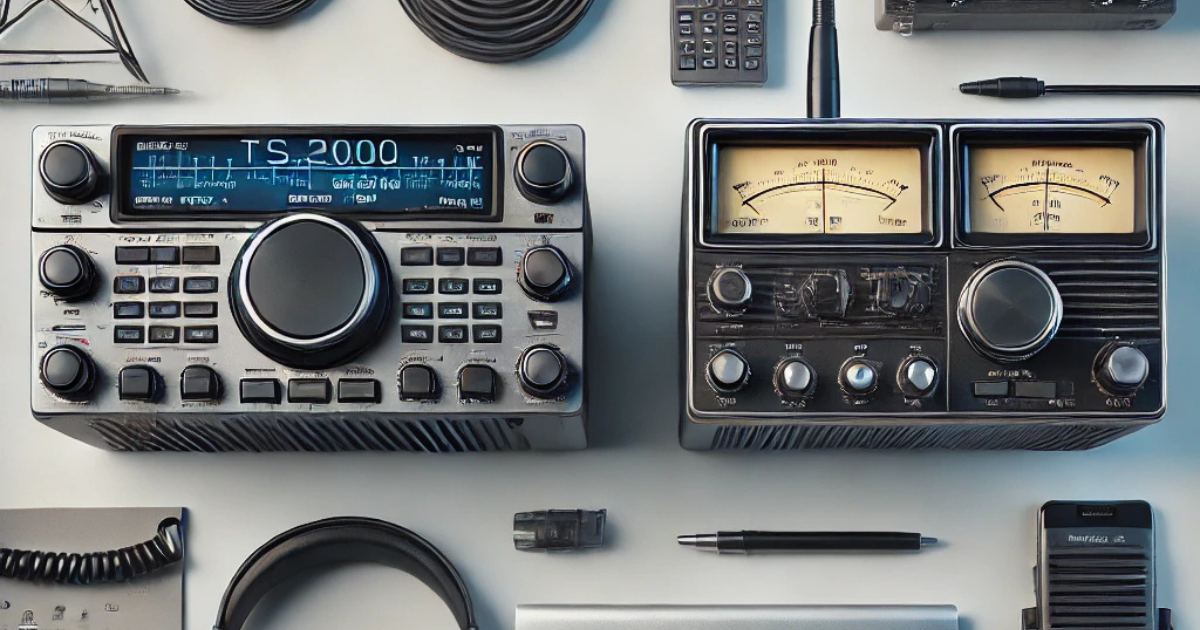In the world of amateur radio, two iconic models frequently rise to the forefront of discussions: the Kenwood TS2000 vs Yaesu FRG 7700. Both have earned their place in the hearts of enthusiasts, but which one suits your needs best? This article dives deep into their features, strengths, and unique characteristics to help you make an informed decision.
Understanding the Basics of the Kenwood TS2000
The Kenwood TS2000, often regarded as a powerhouse in the ham radio community, is a multi-band, multi-mode transceiver. Launched with the goal of delivering versatility, it combines HF, VHF, and UHF capabilities into one compact unit. Its reputation stems from its ability to handle diverse operating conditions, making it ideal for seasoned operators.
With features like built-in DSP (Digital Signal Processing), satellite operation capabilities, and compatibility with external devices, the TS2000 stands out as a highly adaptable device. Its wide frequency range ensures it can handle both local and long-distance communications effortlessly.
In addition to its performance, the Kenwood TS2000 boasts a user-friendly interface. Its comprehensive LCD display and intuitive controls make it easy to navigate even for users transitioning from simpler setups. Whether you’re chasing DX signals or experimenting with satellites, the TS2000 proves to be a reliable companion.
Understanding the Basics of the Yaesu FRG 7700
The Yaesu FRG 7700, on the other hand, is a receiver that has stood the test of time. Designed primarily for shortwave enthusiasts, it is renowned for its reliability and simplicity. Though it lacks the transmission capabilities of the Kenwood TS2000, it compensates with superior reception features and robust performance.
Released in the late 1970s, the FRG 7700 was designed for those seeking high-quality signal reception. Its wideband coverage, spanning from 150 kHz to 30 MHz, makes it an excellent choice for monitoring amateur bands, international broadcasts, and utility signals.
One of the FRG 7700’s standout features is its stability. It delivers consistent performance without the need for frequent adjustments, making it a favorite among listeners who value ease of use. Despite being a vintage model, it continues to be celebrated for its straightforward functionality and durability.
The Key Differences Between the Kenwood TS2000 and Yaesu FRG 7700
While both the Kenwood TS2000 and Yaesu FRG 7700 serve unique purposes, their differences are striking. The TS2000’s multifunctionality as a transceiver contrasts sharply with the FRG 7700’s focus on reception.
The Kenwood TS2000’s ability to transmit on multiple bands gives it a significant edge for ham radio operators. In comparison, the Yaesu FRG 7700 excels as a receiver, offering unmatched stability and simplicity. Where the TS2000 embraces modern technology, the FRG 7700 appeals to those with an appreciation for vintage charm.
Another key difference lies in their user base. The TS2000 is ideal for advanced operators who require a versatile all-in-one solution. Meanwhile, the FRG 7700 caters to hobbyists and shortwave listeners looking for reliable performance without the complexity of transmission.
Performance Overview: Kenwood TS2000 vs Yaesu FRG 7700
The Kenwood TS2000 shines in its ability to perform across multiple bands and modes. Its signal reception and transmission quality are exceptional, ensuring clear communication even in challenging conditions. With its wide frequency range, the TS2000 provides flexibility that few other transceivers can match.
The Yaesu FRG 7700, however, delivers excellent reception performance within its designated range. Its IF filtering and noise reduction capabilities enable it to pick up weak signals with remarkable clarity. While it may not match the TS2000’s versatility, it is a powerhouse in its own right for dedicated shortwave listeners.
Design and Build Quality Comparison
Design is another area where these two models differ significantly. The Kenwood TS2000 features a compact and modern design with a large LCD display, providing detailed information at a glance. Its controls are well-organized, making it easy to access various functions during operation.
The Yaesu FRG 7700, true to its vintage roots, sports a classic design that appeals to enthusiasts of older equipment. Its durable metal casing and straightforward interface emphasize functionality over aesthetics. While it may lack the sleekness of modern devices, its build quality ensures long-lasting performance.
Advanced Features of the Kenwood TS2000
The Kenwood TS2000 is packed with advanced features that cater to experienced users. Its multi-band capabilities allow operators to switch seamlessly between HF, VHF, and UHF bands. The built-in DSP enhances audio clarity by reducing noise and improving signal quality.
Satellite operation is another standout feature of the TS2000. Its ability to track and communicate with satellites opens up exciting possibilities for operators looking to expand their horizons. Additionally, the TS2000 supports remote operation, enabling users to control the device via a PC or smartphone.
Also Read: Uncuymaza
Advanced Features of the Yaesu FRG 7700
The Yaesu FRG 7700 focuses on delivering exceptional reception quality. Its wideband coverage allows users to monitor a diverse range of frequencies, from amateur bands to international broadcasts. The built-in IF filtering provides precise signal tuning, ensuring optimal performance even in crowded bands.
One of its unique features is the ability to add optional modules, such as the memory unit or VHF converter, which enhance its capabilities. These modular upgrades make the FRG 7700 a flexible choice for users looking to customize their listening experience.
Audio Quality: Kenwood TS2000 vs Yaesu FRG 7700
When it comes to audio quality, the Kenwood TS2000 excels with its DSP technology. It delivers clear and distortion-free audio, making it ideal for both transmission and reception. The TS2000’s adjustable audio settings allow users to fine-tune the sound to their preferences.
The Yaesu FRG 7700, while lacking DSP, offers excellent audio clarity for a receiver of its era. Its well-designed circuitry ensures minimal noise, providing an enjoyable listening experience. The FRG 7700’s audio output is particularly well-suited for headphone use, making it a favorite among shortwave enthusiasts.
User Interface and Usability
The Kenwood TS2000’s user interface is designed with modern operators in mind. Its LCD display and intuitive menu system make navigation straightforward, even for complex functions. The ergonomic layout of its controls ensures a smooth operating experience.
The Yaesu FRG 7700, on the other hand, keeps things simple. Its analog display and tactile controls offer a nostalgic experience for users who appreciate vintage equipment. While it may lack the convenience of modern interfaces, its straightforward design makes it easy to use.
Conclusion: Which One Fits Your Needs Best?
Choosing between theKenwood TS2000 vs Yaesu FRG 7700 ultimately depends on your needs and preferences. If you’re looking for a versatile transceiver with advanced features, the Kenwood TS2000 is the clear winner. Its multi-band capabilities and modern technology make it a top choice for experienced operators.
For those who prioritize reception quality and simplicity, the Yaesu FRG 7700 is an excellent option. Its vintage charm, reliable performance, and ease of use make it a favorite among shortwave listeners.
No matter which model you choose, both the Kenwood TS2000 and Yaesu FRG 7700 offer unique strengths that cater to different segments of the amateur radio community.










